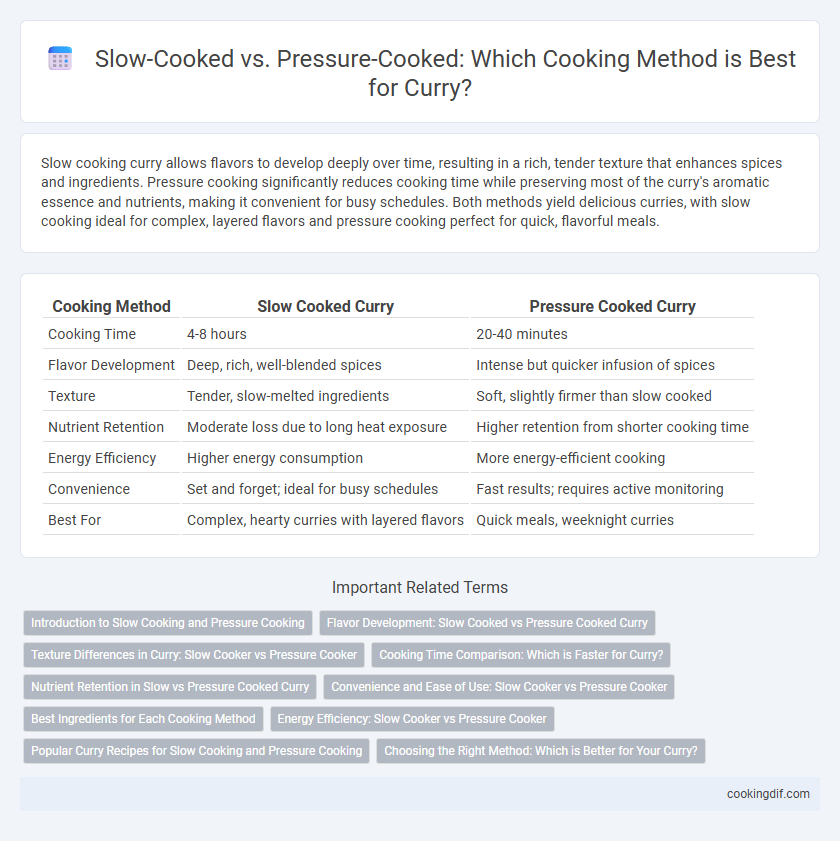Slow cooking curry allows flavors to develop deeply over time, resulting in a rich, tender texture that enhances spices and ingredients. Pressure cooking significantly reduces cooking time while preserving most of the curry's aromatic essence and nutrients, making it convenient for busy schedules. Both methods yield delicious curries, with slow cooking ideal for complex, layered flavors and pressure cooking perfect for quick, flavorful meals.
Table of Comparison
| Cooking Method | Slow Cooked Curry | Pressure Cooked Curry |
|---|---|---|
| Cooking Time | 4-8 hours | 20-40 minutes |
| Flavor Development | Deep, rich, well-blended spices | Intense but quicker infusion of spices |
| Texture | Tender, slow-melted ingredients | Soft, slightly firmer than slow cooked |
| Nutrient Retention | Moderate loss due to long heat exposure | Higher retention from shorter cooking time |
| Energy Efficiency | Higher energy consumption | More energy-efficient cooking |
| Convenience | Set and forget; ideal for busy schedules | Fast results; requires active monitoring |
| Best For | Complex, hearty curries with layered flavors | Quick meals, weeknight curries |
Introduction to Slow Cooking and Pressure Cooking
Slow cooking involves simmering curry ingredients at low temperatures over an extended period, enhancing flavor depth and tenderizing meats through gradual heat exposure. Pressure cooking uses high steam pressure to cook curry rapidly, preserving essential spices and nutrients while dramatically reducing cooking time. Both methods optimize taste and texture, catering to different time constraints and culinary preferences in curry preparation.
Flavor Development: Slow Cooked vs Pressure Cooked Curry
Slow-cooked curry allows spices and ingredients to meld gradually, resulting in a richer, deeper flavor profile with enhanced complexity and aromatic intensity. Pressure cooking accelerates the process by using high heat and steam, preserving bright, vibrant spice notes while infusing the dish efficiently. Both methods impact flavor development uniquely: slow cooking maximizes depth and tenderness, whereas pressure cooking emphasizes speed without sacrificing essential taste layers.
Texture Differences in Curry: Slow Cooker vs Pressure Cooker
Slow-cooked curry develops a tender, richly infused texture as prolonged heat breaks down tough meat fibers and melds spices evenly throughout the sauce. Pressure cooking delivers a quicker, slightly firmer texture with distinct layers of flavor, preserving individual ingredient integrity but sometimes sacrificing depth from slow simmering. Choosing between slow cooking and pressure cooking affects the curry's mouthfeel, with slow cooking favoring softness and pressure cooking prioritizing speed with robust, concentrated flavors.
Cooking Time Comparison: Which is Faster for Curry?
Pressure cooking significantly reduces the cooking time for curry, often completing in 20-30 minutes compared to slow cooking's 4-6 hours. Slow cooking allows flavors to develop gradually, but pressure cooking achieves tender meats and rich spices much faster. For quick, flavorful curry, pressure cooking is the optimal method in terms of efficiency and time-saving.
Nutrient Retention in Slow vs Pressure Cooked Curry
Slow cooked curry allows flavors to meld and develops a rich taste while preserving heat-sensitive vitamins like B-complex and C due to lower temperatures over extended periods. Pressure cooking significantly reduces cooking time and retains more minerals such as potassium and magnesium by minimizing nutrient leaching into the cooking liquid. Both methods offer distinct nutrient retention benefits: slow cooking enhances bioavailability of certain antioxidants, whereas pressure cooking preserves water-soluble vitamins more effectively.
Convenience and Ease of Use: Slow Cooker vs Pressure Cooker
Slow cookers offer exceptional convenience by allowing ingredients to simmer unattended for hours, requiring minimal preparation and frequent monitoring. Pressure cookers significantly reduce cooking time, making them ideal for quick meal preparation while maintaining flavors, though they require initial familiarity to operate safely. Both appliances simplify curry cooking but cater to different timing needs and user preferences in kitchen ease.
Best Ingredients for Each Cooking Method
Slow cooking curry enhances rich, tougher ingredients like beef, lamb, or root vegetables, allowing flavors to deeply meld over extended hours, resulting in tender, melt-in-the-mouth textures. Pressure cooking suits quick-cooking ingredients such as chicken, fish, and legumes, efficiently infusing spices while preserving moisture and nutrition within a shorter time frame. Choosing slow cooking for dense meats and pressure cooking for delicate proteins or pulses maximizes taste and texture in curry dishes.
Energy Efficiency: Slow Cooker vs Pressure Cooker
Pressure cookers use high pressure to cook food quickly, consuming significantly less energy compared to slow cookers that operate at low temperatures over extended periods. Slow cookers can consume up to 3-4 times more energy due to longer cooking times, whereas pressure cookers complete meals in a fraction of the time, enhancing energy efficiency. For energy-conscious curry preparation, pressure cooking is the optimal method to reduce electricity usage while preserving flavor.
Popular Curry Recipes for Slow Cooking and Pressure Cooking
Slow cooked curries like Beef Rendang and Indian Lamb Vindaloo develop deep, complex flavors as low heat gently breaks down tough meat fibers over hours, enriching spices and coconut milk. Pressure cooked curries such as Chicken Tikka Masala and Thai Green Curry offer a faster alternative, preserving aromatic herbs and tenderizing ingredients within minutes by rapidly increasing steam pressure. Both methods enhance curry taste profiles, but slow cooking excels in richness and texture while pressure cooking prioritizes convenience and vibrant, fresh flavors.
Choosing the Right Method: Which is Better for Your Curry?
Slow cooking curry allows flavors to meld gradually, enhancing depth and tenderness, ideal for tougher cuts of meat and rich, complex sauces. Pressure cooking drastically reduces cooking time, locking in moisture and intensifying spices, perfect for quick meals without sacrificing taste. Choosing between methods depends on time availability and desired flavor development, with slow cooking favored for richness and pressure cooking for convenience.
Slow Cooked vs Pressure Cooked for cooking method Infographic

 cookingdif.com
cookingdif.com